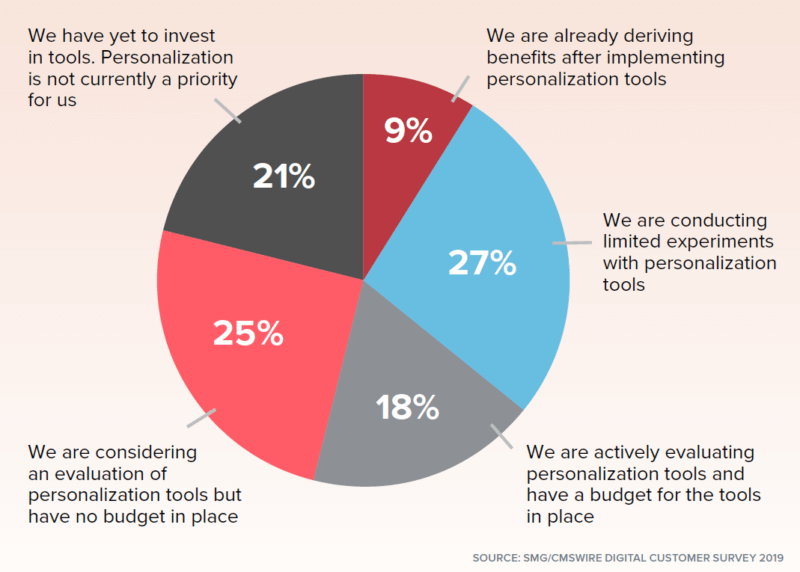One would think that with more than 7,000 martech tools available to create exceptional digital customer experiences, businesses would have little trouble building a marketing stack that delivers a seamless customer journey — but that doesn’t appear to be the case, according to Simpler Media’s latest State of Digital Experience report.
Of the 325 digital customer experience executives surveyed by Simpler Media, 79% said digital customer experience (DCX) was an extremely or very high priority for their organization. Yet, nearly half (46%) reported they had yet to invest in personalization tools or had no budget in place for such technology. Just 9% said they are using personalization tools, while 27% said they are testing them.
How would you describe your organization’s use of digital customer experience personalization tools?
“We can’t take personalization out of the broader digital experience,” said Siobhan Fagan, managing editor of CMSWire. Fagan presented the report findings during her keynote at the DX Summit in Chicago. “You need, of course, the technology that makes it all possible.”
The 9% figure is actually a drop from last year when 14% said they were seeing results with personalization — not a strong sign in terms of how personalization tools or their utilization have evolved over the past year.
Businesses want more customer insights, but fail to utilize metrics
Prioritizing DCX, but not personalization tools, wasn’t the only disconnect revealed by the report.
Ninety percent of the DCX executives surveyed said they lacked insights that explain why their customers are doing what they’re doing, with only 11% reporting that they understood their customers’ behavior well — 33% rated their understanding of their customer behavior as poor. Fifty-two percent said they “moderately” understood their customer behavior (which, honestly, sounds only slightly better than “meh”).
At the same time, the majority of the survey respondents (57%) reported they were using just three or fewer metrics. Of the companies using one to two metrics, 54% claimed the “effectiveness” of their measurement tools needed work. For the companies using three to four metrics, 48% said the “effectiveness” of the tools needed work.
This may be changing, however. When asked to name their organization’s DCX investment priorities, 59% — the largest share — listed analytics, insights and dashboarding. Also, nearly a third of the survey respondents said improved analytics was a top customer data management priority for their organization.
Silos are a top challenge for DCX teams
When listing their top challenges in terms of creating and implementing effective DCX efforts, 47% said siloed systems and fragmented customer data and 42% reported limited cross-department alignment and collaboration. Arguably, these two challenges — siloed systems and limited cross-department alignment — could fit under the same umbrella. In other words, a large majority of DCX professionals want more connectivity across organization departments.
This finding backs up customer experience expert Kerry Bodine’s premise that silos are the biggest obstacle in the customer journey. While silos may enable businesses to make things happen at scale that would otherwise be impossible, they are terrible for customers who are trying to accomplish different tasks, says Bodine.
The DCX industry’s take on martech
Looking at the nuts and bolts of the systems used to create digital customer experiences, 46% said their current platforms and tools need work. Forty-one percent said the tools they used were satisfactory and 13% reported they worked well. At the same time, 60% reported they were currently evaluating, upgrading or shopping for new CMS platforms or digital experience platforms. Translation: There are more DCX executives who are either not happy — or would rate their tools “satisfactory” — than the number of executives actually looking to invest in new platforms.
Interestingly, on the CDP front, 23% reported having already purchased a CDP, and more than a third (34%) are evaluating options. Meanwhile, 13% have decided against a CDP and 28% are undecided. It’s a close split, but the fact that more DCX executives are either already committed to using — or are evaluating — a CDP shows the industry is open to adopting systems that can help build a unified view of the customer.
“Nobody wants to go back to the days when customers are viewed and treated the same,” said Fagan from the DX Summit stage, “We need to look at our digital experience efforts as part of a bigger whole, not piecemealed together.”

